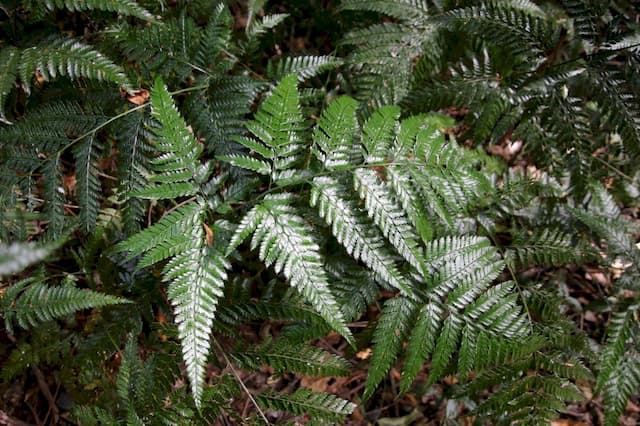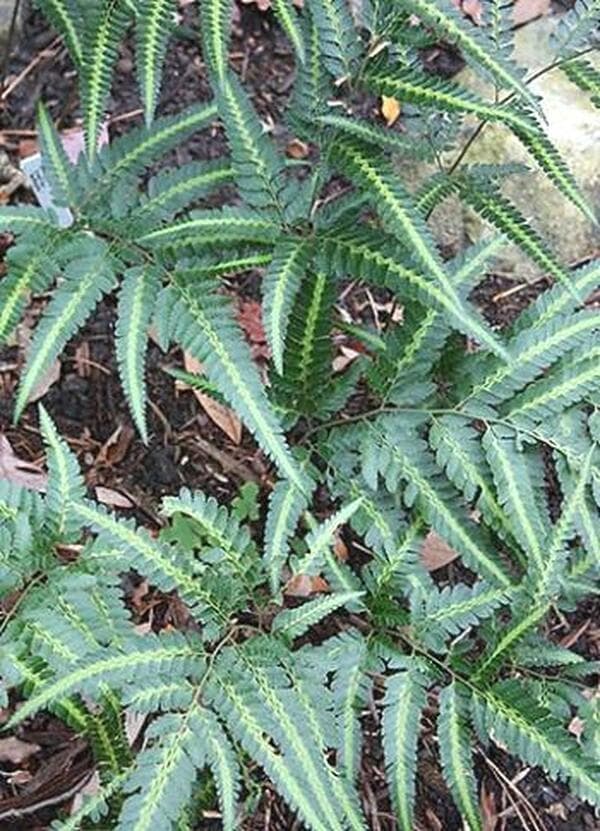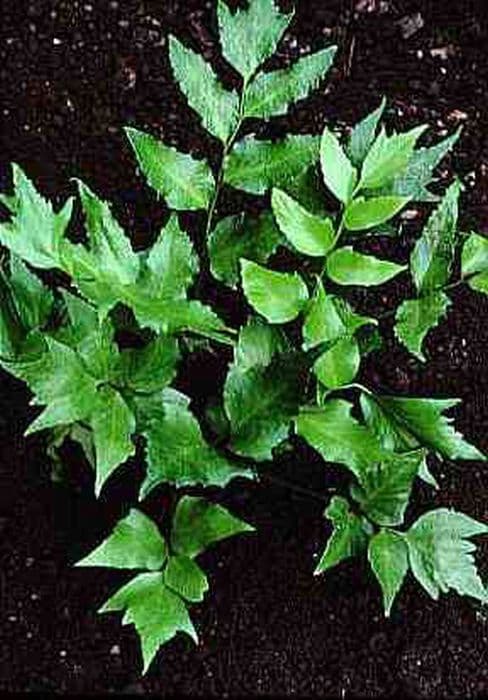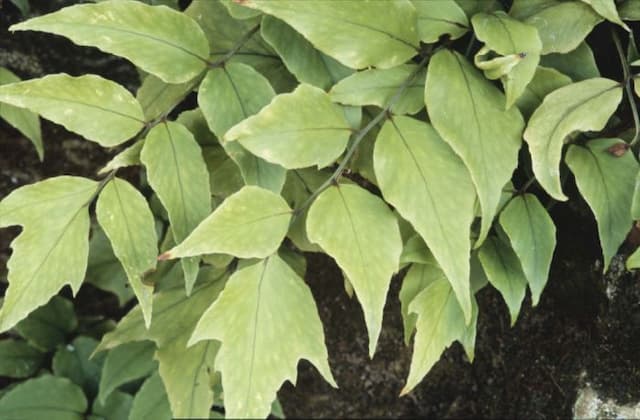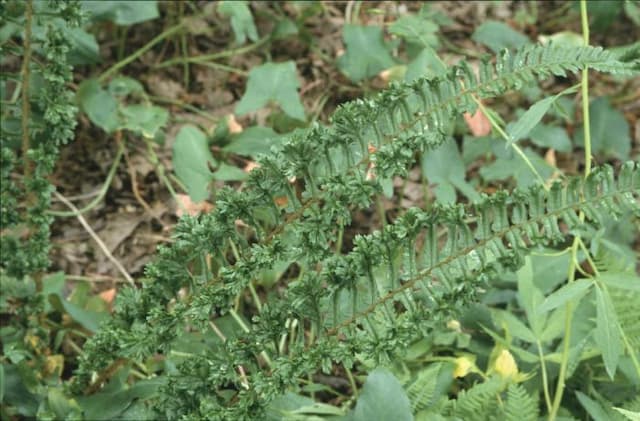Male fern Dryopteris filix-mas 'Grandiceps Wills'











ABOUT
The plant known as Male Fern features fronds that are robust and upright with a rich, bright green color. Each frond is divided into numerous leaflets that have a somewhat leathery texture, giving the plant a dense and lush appearance. The fronds display an intricate, feathery pattern that is both elegant and complex, with each leaflet having a series of smaller divisions that enhance the fern's intricate visual texture. What sets 'Grandiceps Wills' apart is the unique cresting at the tips of the fronds and leaflets. These crested tips are eye-catching as they give the fronds a ruffled or tasseled appearance, adding an ornate quality to the plant. The distinctive cresting may remind one of a finely detailed ornamental design, contributing to the plant’s attractiveness in a shade garden or woodland setting. Overall, the fronds arc outwards and form a fountain-like shape that gracefully fills the space. The leaves emerge from a central point, creating a natural and symmetrical rosette that radiates outward with a textured, layered effect. This variety retains the classic charm of Male Ferns, with the added flourish of its uniquely embellished fronds.
About this plant
 Names
NamesFamily
Dryopteridaceae.
Synonyms
Male Fern, Common Male Fern, Shield Fern.
Common names
Aspidium filix-mas (L.) Sw., Dryopteris austriaca (Jacq.) Woynar, Lastrea filix-mas (L.) Bory, Nephrodium filix-mas (L.) Michx., Polypodium filix-mas L., Thelypteris filix-mas (L.) Sloss.
 Toxicity
ToxicityTo humans
The plant commonly known as Male Fern is not typically considered toxic to humans. However, like many plants, it is not intended for consumption and may cause mild stomach discomfort if ingested in large quantities.
To pets
Male Fern is not commonly listed as a toxic plant to pets. Nonetheless, ingestion of non-food plants by pets can sometimes lead to gastrointestinal upset, such as vomiting or diarrhea. It is always best to prevent pets from consuming any plants to avoid potential adverse reactions.
 Characteristics
CharacteristicsLife cycle
Perennials
Foliage type
Evergreen
Color of leaves
Green
Height
3 feet [91 cm]
Spread
3 feet [91 cm]
Plant type
Fern
Hardiness zones
5
Native area
Europe
Benefits
 General Benefits
General Benefits- Ornamental Appeal: Male fern 'Grandiceps Wills' is known for its unique and attractive foliage, enhancing garden aesthetic.
- Shade Tolerance: It thrives in shady areas where other plants may struggle, making it suitable for woodland gardens and shaded borders.
- Drought Resistance: Once established, it is relatively drought-tolerant, requiring less frequent watering than many other fern species.
- Wildlife Habitat: Provides shelter and habitat for various wildlife species, including birds and insects.
- Soil Erosion Control: The fern's root system helps stabilize soil and prevent erosion, particularly on slopes or in areas with loose soil.
- Easy Maintenance: Generally requires minimal care once established, with no need for regular pruning or deadheading.
- Seasonal Interest: Adds texture and greenery to gardens throughout the growing season and often has appealing autumnal color before dying back in winter.
- Non-Invasive: Unlike some other ferns, Dryopteris filix-mas 'Grandiceps Wills' is not known for being invasive, making it a considerate choice for mixed plantings.
 Medical Properties
Medical Properties- Anthelmintic: Historically used for expelling worms (vermifuge) from the intestine.
- Astringent: May have been used to help contract body tissues or canals, such as the intestines.
- Purgative: In the past, the root was sometimes used as a strong laxative to relieve constipation.
 Air-purifying Qualities
Air-purifying QualitiesThis plant is not specifically known for air purifying qualities.
 Other Uses
Other Uses- Textile colorant: The fronds of Male Fern can be used to create a natural dye for textiles, offering a way to impart a green hue to fabrics using traditional dyeing methods.
- Garden sculpture substitute: The intricate fronds of the Male Fern, especially when dried, can be used in place of sculptures to add an artistic element to garden designs.
- Natural mulch: Dead or trimmed fern fronds can be laid around the base of plants as a natural mulch, helping to retain soil moisture and suppress weeds.
- Floral arrangements: Fresh or dried fronds of the Male Fern can be incorporated into floral arrangements for their textural contrast and enduring greenery.
- Photography: With its unique structure and beautiful pattern, Male Fern can be used as a subject or backdrop for botanical photography.
- Education: This fern species can be employed in educational settings to demonstrate plant structure, lifecycle, and spore reproduction to students.
- Companion planting: Male Fern can be planted alongside shade-loving plants to create a lush, green woodland garden aesthetic.
- Habitat creation: By planting Male Ferns, gardeners can provide habitats for a variety of insects and small animals, supporting local biodiversity.
- Pond-side planting: The fern can be used to naturalize the edges of ponds or water features, thereby enhancing the riparian environment in the garden.
- Seasonal decoration: During the fall, the changing colors of fern fronds can be harvested and used to create seasonal decorations, such as wreaths or table centerpieces.
Interesting Facts
 Feng Shui
Feng ShuiThe Male Fern is not used in Feng Shui practice.
 Zodiac Sign Compitability
Zodiac Sign CompitabilityThe Male Fern is not used in astrology practice.
 Plant Symbolism
Plant Symbolism- Protection: "Male Fern," as Dryopteris filix-mas is commonly known, has been linked with protective qualities in folklore, where it was believed to ward off malevolent spirits and creatures.
- Secrecy: Since ferns have a long history of being associated with hidden wisdom and secret knowledge, the Male Fern can symbolize the hidden or the unseen truths of the natural world.
- Health: Ferns in general, including Male Fern, have traditionally been used for healing in various cultures, hence they often symbolize health and well-being.
- Eternal Youth: The unfurling of new fronds which resembles the crosier of a bishop - which can be seen as a symbol of renewal, youth, and new beginnings.
 Water
WaterThe Male Fern (Dryopteris filix-mas 'Grandiceps Wills') should be watered deeply once a week, allowing the soil to dry out slightly between waterings. Water the plant with approximately 1 gallon of water at each watering session, directing the water at the base of the plant to avoid wetting the fronds. During the winter months or in cooler climates, the watering frequency may be reduced to every other week, paying close attention to the moisture level of the soil. It is important not to overwater as this can lead to root rot, so ensure good drainage in the pot or planting area.
 Light
LightThe Male Fern thrives best in partial shade to full shade, with indirect sunlight being ideal. It should be placed in a spot that avoids the intense midday sun which can scorch its delicate fronds. A north-facing or east-facing location that receives gentle morning light or dappled sunlight underneath taller trees or shrubs is optimal.
 Temperature
TemperatureThe Male Fern prefers cooler temperatures and can tolerate a wide range from around 35°F to 75°F. It is hardy in winter but should be protected from extreme cold and frost that can dip below the survival range. The ideal temperature range for this fern is between 60°F and 70°F, which promotes healthy growth.
 Pruning
PruningPruning the Male Fern is mostly about removing dead or damaged fronds to maintain a tidy appearance and promote healthy growth. Prune in early spring before new growth starts, typically once a year. Cut back the old fronds to the base of the plant to make room for fresh new fronds to emerge.
 Cleaning
CleaningAs needed
 Soil
SoilThe best soil mix for Male Fern (Dryopteris filix-mas 'Grandiceps Wills') should be rich in organic matter, moisture-retentive, yet well-draining, with a slightly acidic to neutral pH of 6.0 to 7.0. A mix of loam, peat, and sand or perlite in equal parts can foster healthy growth.
 Repotting
RepottingMale Fern should be repotted every couple of years or when it becomes root-bound. It's best to do this in the springtime, just before the growing season begins for optimal recovery and growth.
 Humidity & Misting
Humidity & MistingMale Fern thrives in medium to high humidity conditions. Maintaining a humidity level of around 60% is ideal for this plant, which can be achieved with regular misting or placing a humidifier nearby.
 Suitable locations
Suitable locationsIndoor
Place Male Fern in indirect light, ensure high humidity.
Outdoor
Choose shaded spot, protect from direct sun and wind.
Hardiness zone
Male Fern is suitable for 3-8 USDA hardiness zones.
 Life cycle
Life cycleThe common name for Dryopteris filix-mas 'Grandiceps Wills' is Male Fern. It begins its life as a spore that germinates to produce a small, heart-shaped gametophyte (prothallus) which is the sexual stage of the plant where sperm and eggs are produced. Upon fertilization, the zygote develops into a young fern (sporophyte), growing its first fronds from an underground rhizome. As the Male Fern matures, it produces larger and more robust fronds each spring, which uncurl from tightly coiled 'fiddleheads'. Throughout its life, the fern maintains a perennial habit, dying back to the rhizome in winter to avoid frost damage and regrowing in spring. Finally, mature ferns develop sori on the undersides of their fronds, which release spores to begin the cycle anew.
 Propogation
PropogationPropogation time
Late summer to early fall
The most popular method of propagation for the Male Fern, scientifically known as Dryopteris filix-mas 'Grandiceps Wills', is through spore propagation. Typically, the best time to collect spores is in the summer when the spores are ripe. The underside of the fern's fronds will develop spore cases called sori, which are collected by cutting the frond and placing it inside a paper bag. As the fronds dry, the spores will be released into the bag. These spores can then be sown on the surface of a sterilized, damp, seed-starting mix and kept at room temperature or slightly warmer, around 70 degrees Fahrenheit (21 degrees Celsius), in indirect light. The medium should be enclosed with a plastic wrap to maintain humidity until germination, which can take several weeks to a few months. Once the spores have germinated and the young ferns have grown sufficiently to handle, they can be transplanted into individual pots.
